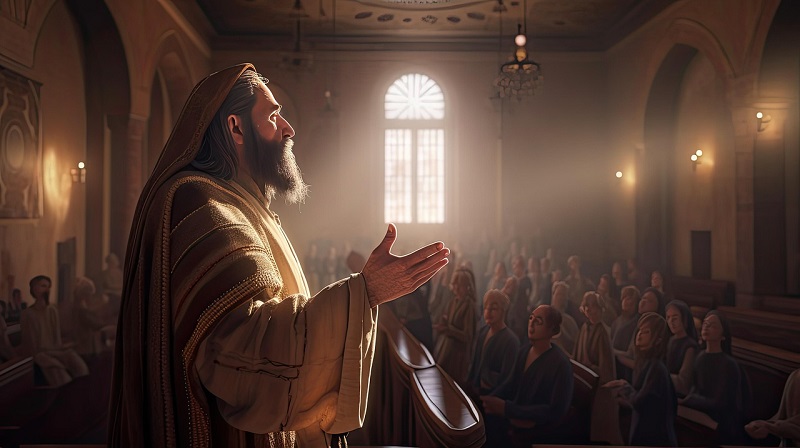Have you ever considered how gratitude can shape your relationship with God?
The Bible offers numerous examples of thanksgiving that not only illustrate its significance but also serve as valuable lessons for modern believers.
In this article, we’ll uncover these examples of thanksgiving in the Bible, providing context and insights that emphasize why thankfulness matters in our spiritual journeys.
Join me as I explore how these ancient teachings remain relevant and inspiring today.
✅ The 7 Examples of Thanksgiving in the Bible

This section explores these examples and offers practical ways to incorporate biblical gratitude into your life today.
1. Abraham’s Gratitude to God
Abraham’s journey is a profound testament to gratitude, standing as one of the most compelling examples of thanksgiving in the Bible.
When faced with the news of becoming a father at such an advanced age, Abraham didn’t express doubt; instead, his response was one of unwavering faith.
This moment is pivotal; it highlights how gratitude can profoundly reshape our perspective, allowing us to embrace promises that seem impossible.
Abraham’s obedience following the promise of his son Isaac illustrates a deeper layer of thanksgiving.
Every act of faith he undertook — from leaving his homeland to showing readiness to sacrifice Isaac — was rooted in a heart that recognized God’s sovereignty and faithfulness.
This kind of gratitude is not merely verbal but is demonstrated through actions, reminding us that true thankfulness often manifests in how we live our lives.
Each step of Abraham’s journey invites us to consider how we can respond to God’s blessings with the same heartfelt gratitude, recognizing that even when circumstances appear uncertain, His promises remain steadfast.
2. Hannah’s Prayer of Thanksgiving
Hannah’s Prayer of Thanksgiving stands out as a profound example of sincere gratitude in the Bible.
After years of disappointment and pleading, her joy overflowed, not merely in words, but in action.
By dedicating Samuel to God’s service, Hannah demonstrated that thanksgiving is a holistic experience — one that encompasses both the heart and the hands.
This act reminds us how vital it is to align our blessings with purpose, transforming personal gifts into communal offerings.
Her story invites us to reflect on our own lives and the examples of thanksgiving in the Bible.
Just as Hannah turned her joy into service, we are encouraged to share our blessings and express our gratitude in meaningful ways, whether through acts of kindness, service to others, or worship.
In a culture that often emphasizes individualism, Hannah’s dedication underscores a powerful truth: true thanksgiving springs forth not just from what we receive but from how we choose to honor and invest those blessings back into the world around us.
3. David’s Psalms of Thanksgiving
In the tapestry of King David’s Psalms, we find a rich collection of stories of thanksgiving in the Bible that resonate with timeless relevance.
Psalm 100 is a jubilant call to worship, inviting us to enter the Lord’s presence with gladness and joy.
David’s exhortation to “make a joyful noise” not only underscores the importance of gratitude but also highlights how communal expressions of thankfulness can unite hearts and spirits in worship.
His songs remind us that no matter our circumstances, there is always a reason to celebrate God’s enduring goodness.
Similarly, Psalm 107 unfolds as a profound narrative of deliverance, recounting the various trials faced by the people and the steadfast mercy of God that follows.
Each verse serves as a testament to how gratitude can transform our perspective, urging us to remember the blessings that flow even amidst struggles.
David’s poetic language acts as a bridge, connecting ancient experiences with our modern lives, urging us to catalog our own stories of thanksgiving.
By embracing David’s example, we can cultivate a lifestyle of gratitude, using prayer and song to articulate our deepest appreciation for the divine guidance and love we experience daily.
4. Israelites’ Thankfulness after Deliverance
The stories of thanksgiving in the Bible reveal a profound connection between gratitude and communal identity.
When the Israelites crossed the Red Sea, their immediate response was not just personal relief but a jubilant celebration together, led by Miriam’s song.
This collective expression of thankfulness fortified their bond as a people, reminding them that their deliverance wasn’t just an individual experience but a shared triumph over adversity.
This communal aspect of gratitude highlights how such expressions can transform collective memory into a foundation for faith and resilience.
In the wilderness, the recurring theme of God’s provision prompted the Israelites to gather and recount their blessings.
When manna fell from the heavens, instead of merely acknowledging their daily bread, they celebrated the miracle collectively.
Often, these acts of thanksgiving not only served to honor God but also reinforced their unity and identity as a nation under divine favor.
Through these stories, we learn that thankfulness, especially in community, can be a powerful catalyst for hope and renewal, helping us navigate both the trials of life and the joys of deliverance.
5. Jesus’ Thanksgiving in the Gospels
Throughout the Gospels, Jesus’ thanksgiving moments reveal profound layers of meaning, illuminating how gratitude intertwines with faith.
Before the miraculous feeding of the 5,000, His act of giving thanks for the humble loaves and fishes demonstrates that acknowledgment of what we have, however small, can set the stage for divine abundance.
This moment teaches us that gratitude isn’t merely a prelude to receiving blessings; it’s a catalyst for miracles, encouraging us to celebrate the ordinary as sacred.
During the Last Supper, Jesus offers thanks for the bread and wine even in the shadow of impending betrayal and suffering.
This poignant act invites us to reflect on the power of gratitude amidst adversity.
The thanksgiving stories in the Bible, particularly those linked to Jesus, remind us that we can find joy and connection, no matter our circumstances.
Emulating Jesus, we can cultivate a heart that recognizes the sacred in daily life, transforming mundane moments into opportunities for thanksgiving.
6. Paul’s Letters on Gratitude
Paul’s letters reveal a profound understanding of gratitude as a cornerstone of Christian faith.
In 1 Thessalonians 5:18, he exhorts believers to “give thanks in all circumstances,” not merely as a rote obligation but as an essential practice that cultivates resilience.
This perspective invites us to see gratitude through a lens of deeper spiritual growth; when we express thankfulness, even amid trials, we are practicing a powerful form of faith.
The act of thanksgiving transforms our focus, shifting it from our hardships to the unwavering presence of God in our lives.
The examples of thanksgiving in the Bible echo Paul’s teachings, illustrating that gratitude transcends mere expression — it becomes a lifestyle.
For instance, in Philippians 4:6, Paul encourages the faithful to present their requests with thanksgiving, emphasizing that gratitude harmonizes our hearts with God’s peace.
This practice not only enriches our relationship with the divine but also serves as a source of joy and strength in difficult times.
Ultimately, Paul’s letters remind us that cultivating an attitude of gratitude can anchor our souls, enabling us to navigate life’s storms with unwavering faith and renewed hope.
7. Early Christians’ Practices of Thanksgiving
In the early Christian community, thanksgiving wasn’t just an isolated act of gratitude, but a cornerstone woven into the fabric of communal life.
Acts 2:46–47 vividly portrays believers sharing meals with joy and sincerity, emphasizing the transformative power of gratitude in their gatherings.
This practice of breaking bread together served as a tangible expression of their thankfulness to God and one another, reinforcing fellowship and community bonds.
By celebrating daily life’s blessings, they embodied a counter-narrative to societal individualism, cultivating a spirit of generosity and collective joy.
These early examples of thanksgiving in the Bible illustrate not only a dedication to worship but also a profound understanding of interdependence among believers.
Their acts of gratitude were communal, inviting each person to express appreciation, thus building a resilient faith community.
For modern believers, this invites a refreshing challenge: to incorporate intentional practices of thanksgiving in shared moments — be it through communal prayers, shared meals, or acts of service.
Ultimately, reflecting on how early Christians lived out their gratitude can inspire faith communities today to foster authentic connections grounded in thankfulness, inviting a deepened sense of purpose and belonging.
Examples of Thanksgiving in the Bible (Summary)
Thanksgiving in the Bible is more than just a tradition; it is a profound spiritual practice that demonstrates faith, humility, and reliance on God.
From Abraham’s unwavering gratitude for God’s promises to Hannah’s heartfelt prayers and David’s Psalms of thanksgiving, the Scriptures provide clear examples of how to express thankfulness in both joyous and challenging moments.
In the New Testament, Jesus modeled gratitude in everyday life, and the Apostle Paul encouraged believers to maintain a spirit of thanksgiving in all circumstances.
By studying these examples, we can learn to cultivate a consistent practice of gratitude, not only through private prayer but also in communal worship and everyday interactions.
Applying biblical thanksgiving today can transform our perspective, deepen our faith, and bring lasting peace and joy.
When we follow these lessons, our lives reflect God’s goodness, and our hearts remain attuned to His blessings, fostering a lifestyle of gratitude that honors Him daily.
Frequently Asked Questions About Thanksgiving in the Bible
1. What does the Bible say about giving thanks?
The Bible emphasizes giving thanks in all circumstances. 1 Thessalonians 5:18 states, “Give thanks in all circumstances; for this is the will of God in Christ Jesus for you.” Gratitude is seen as an essential part of faith and spiritual growth.
2. Who are some biblical characters known for their thanksgiving?
Key examples include Abraham, Hannah, King David, Jesus Christ, and the Apostle Paul. Each demonstrated gratitude through prayer, praise, and faithful action.
3. How can I practice biblical thanksgiving today?
You can practice biblical thanksgiving through daily prayer, journaling your blessings, expressing gratitude to family and community, and reflecting on scripture that highlights God’s goodness.
4. Why is thanksgiving important in the Bible?
Thanksgiving strengthens our relationship with God, cultivates humility, and encourages joy. It acknowledges God’s blessings and faithfulness, even during difficult times.
5. Can gratitude improve my spiritual life?
Yes. Practicing gratitude, as shown by biblical examples, nurtures a closer connection with God, promotes a positive mindset, and encourages consistent spiritual growth through prayer and reflection.
Other Blog Posts
- 7 Examples of Testimonies in the Bible
- 7 Examples of Temptations in the Bible
- 7 Examples of Teamwork in the Bible

Grounded in faith and driven by purpose, I’m a Christian blogger and online research specialist with a passion for God’s Word, lifelong learning, and healthy living.
